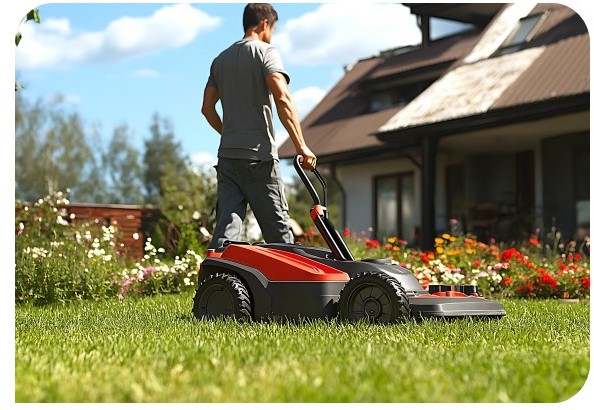Am I aging myself in asking if you remember the Stephen King movie “Lawnmower Man” – back in 1992?
It explored the idea of using technology to enhance intelligence, but it also highlighted the potential dangers of giving a robot a blade. While robotic lawn mowers won’t turn you into a digital being, they do represent a significant leap in lawn care technology. If robotic mowers become more affordable, will more households adopt them? It’s a question worth pondering as we consider whether it’s time for the next robotic invasion—our lawns.
It started with my Robotic Vacuum Journey
I don’t own a robotic lawn mower, but I do own a robotic vacuum. While I love it, my wife thinks I spend more time cleaning IT than IT cleans our floors. The model I bought gets clogged with hair (not mine), and I regret opting for a cheaper version. Despite my love/hate relationship with it, robotic vacuums are widely used nowadays. This is due to improved lidar technology, increased affordability and added functionality (such as mopping). Generally speaking, folks love their robotic vacuums. One of my friends even named theirs and, being the good ‘dog’ it is, cleans up all the crumbs after dinnertime. So, is it prime time for the next robotic invasion to take over your lawn?

Inside the Robo Mower Data
NielsenIQ’s data shows that only about 5% of lawn mower shoppers have purchased a robotic lawn mower, and these are mostly people under the age of 40. Looking at the assortment in major retailers, in our partnership with OpenBrand, robotic mowers represent less than 4% of the overall SKUs across major retailers in the US.
Comparing the prices – a major factor in decision making, we clearly see the shifts from robotic basic models starting at about $600, while high-end models with advanced features costing over $5,000. In comparison, the average price of a regular gas push lawn mower ranges from $100 to $500, and a battery push lawn mower ranges from $150 to $2,000.
The barriers to Robo Mowers
Setting up a robotic lawn mower can be complex, especially if it requires boundary wires. Additionally, these mowers may need more maintenance compared to traditional mowers, which can be a deterrent for some users—similar to robotic vacuums. Robotic mowers may also struggle with very steep slopes, intricate garden layouts, or lawns with many obstacles. This can limit their effectiveness and appeal for people with more complex yard designs—again, similar to robotic vacuums.
And then there’s the trust factor. Are these devices dangerous? Funny we need to ask, can we trust a robot with a blade? The blades can cut through… well, you get the idea. My 12-pound Maltese poodle sunbathing in the backyard who barks at any moving object thinks this is “an accident” waiting to happen. Safety concerns are a significant factor here if you are reminded about what happens in Lawnmower man.
Related trends in lawn care

Other trends in the lawn care market include the rising popularity of cordless technology. Cordless lawn mowers have seen more sales than gas push-behind mowers in recent years. According to OpenBrand data, over 50% of retailers’ assortments currently feature cordless lawn mowers. This shift might be the first step towards embracing robotic mowers. Cordless WB mowers saw steady growth in both unit sales (+12.9%) and revenue (+31.4%), indicating strong consumer adoption and possibly higher average selling prices.
Will Gen Z push Robo Mowers forward?
Another consideration is how Gen Z will handle lawn care as they become homeowners. Gen Z buys more tech than any other generation and they might push the robotic mower segment forward as more Zoomers become homeowners. Additionally, gardeners are harder to find in more rural areas, making robotic mowers a viable option for older homeowners. However, the challenge remains: where can these devices be repaired in rural areas? Can they easily be stolen?
Charting a path forward in Lawn Tech…
So, how can manufacturers address these concerns? It’s a question worth pondering as we consider whether it’s time for the next robotic invasion—our lawns.
As a refresh, NielsenIQ reports all model level details down to a model level. But at CES 2025, we noticed a few of the leading models that include:
- Husqvarna Automower 450XH – Known for its GPS-assisted navigation and weather timer, this model is highly popular for handling large and complex lawns1.
- Greenworks Optimow 50H – This model offers smart connectivity features, including app control and integration with smart home systems, making it a favorite among consumers1.
- Robomow RS630 Pro – Featuring a robust design and powerful cutting system, this model is equipped with smart features like app control and voice commands1.
- Worx Landroid Vision – Known for its advanced vision-based navigation for precise lawn care2.
- Honda Miimo HRM 3000 – Designed for larger lawns with enhanced GPS tracking and smart connectivity features2.
I’m writing this post feeling blessed that I still have all 10 of my fingers. There were several extremely close calls growing up when my severely rusty bladed lawn mower got clogged and I had to well – unclog it. My parents were there to pay me allowance, but certainly weren’t there to hear the chocking of the engine and whirl of the blade get choked up. I survived and times have changed with the advancements in technology.
With robotic vacuums making our indoor lives easier, is the grass always greener with a robotic lawn mower?
Want a deeper dive into Lawn Tech insights from NielsenIQ and OpenBrand?
Produced in Partnership with:






